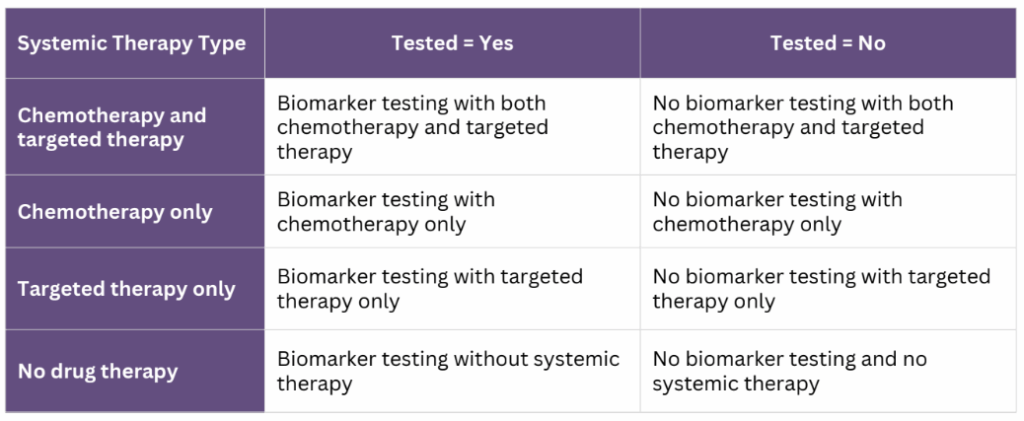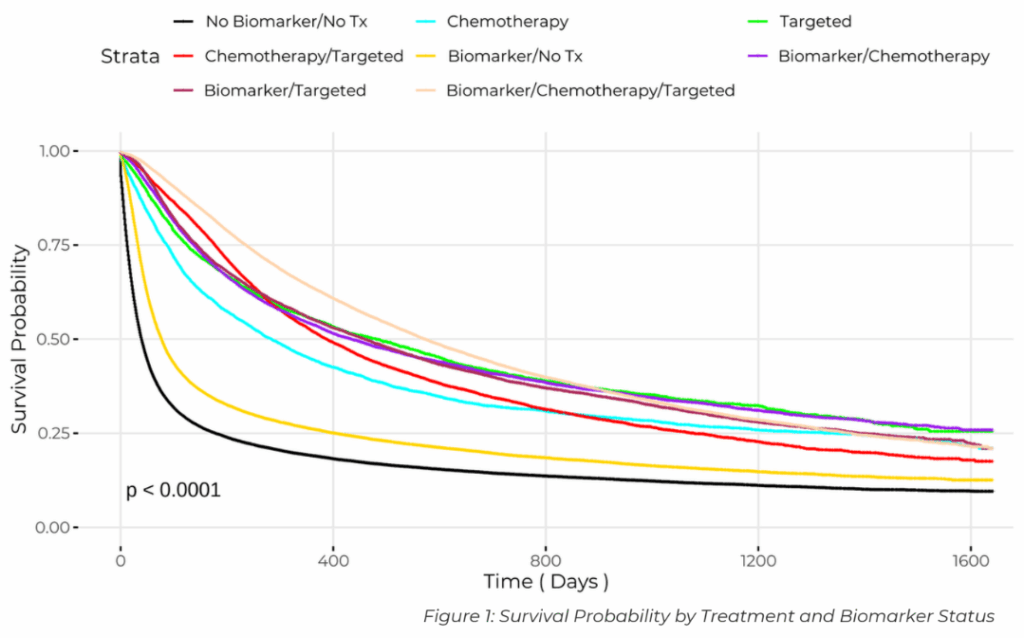Biomarker testing can drastically extend survival across multiple cancer types. But gaps in adoption persist. Are payers, pharma and policymakers doing enough to ensure these tests actually having an impact in the real world?
PurpleLab recently conducted a study, Maximizing Survival: The Real-World Impact of Biomarker Testing in Metastatic NSCLC, to shed light on how biomarker testing impacts survival for people with metastatic non-small cell lung cancer (NSCLC).
Using our CLEAR claims database, we explored testing and treatment patterns and how they influenced outcomes for more than 167,000 patients. The findings were stark, yet surprising: patients who receive comprehensive biomarker testing and guideline-directed treatment live significantly longer.
For decision makers across healthcare, what this shows is that improving testing rates is one of the highest-impact and most actionable levers available to improve survival and ensure healthcare dollars are spent effectively.
Why Biomarker Testing Matters
Many cancers, including NSCLC, the focus of our latest study, can be driven by specific genetic mutations. Identifying which mutations are present in the tumor through biomarker testing allows providers to prescribe targeted therapies specifically designed for those tumor types.
Targeted therapies only work when the correct mutation is identified, which is why the National Comprehensive Cancer Network (NCCN) requires testing before treatment.
Despite these guidelines, testing is inconsistent across different providers and patient populations. Yet skipping biomarker testing may mean patients miss out on opportunities to receive life-extending treatments. Our previous analysis, Provider Variation in Biomarker Testing and Mortality Among Patients with Metastatic NSCLC, further highlights how provider-level differences can directly influence outcomes, underscoring the need for consistent testing practices to ensure equitable access to life-saving therapies.
For payers, low adoption of biomarker testing can mean higher downstream costs due to inappropriate treatment plans. For pharma, it can mean slower adoption of precision therapies that could demonstrate value.
Therefore, it is important for all stakeholders across the healthcare continuum to understand how frequently biomarker testing is carried out in real-world clinical settings, where there are gaps in testing, and how testing and treatment influence outcomes.
Inside the PurpleLab Study
To understand real-world testing and treatment patterns for patients diagnosed with metastatic NSCLC, we analyzed de-identified claims data from PurpleLab Comprehensive Layout for Exploration Analysis & Research (CLEAR) Claims repository (January 2019 to June 2024).
In total, the study included 167,017 patients with metastatic lung cancer, the majority of whom were aged 65 years or older (83.4%). Patients were divided into eight categories based on whether or not they received biomarker testing and which therapies they went on to receive.

Furthermore, patient demographic and socioeconomic information were pulled from health plan enrollment files, including age at index date, gender, race, ethnicity, marital status, education, occupation, and zip code-level household income.
Our analysis revealed major differences in survival outcomes:
- 573 days median survival for patients who had biomarker testing + chemotherapy + targeted therapy
- 481-459 days for those on targeted therapy, with or without biomarker testing
- 284 days for patients who received chemotherapy only
- 77 days for patients with biomarker testing but no follow-up treatment
- Only 39 days for those who had neither testing nor treatment

In other words, patients who received both biomarker testing and the appropriate therapy survived on average 496 to 534 days longer than those who received neither testing nor treatment.
Social Factors that Influence Survival
The study also explored how demographics and social determinants of health (SDOH) affect outcomes. Encouragingly, we found that both biomarker testing and therapies were administered relatively consistently regardless of the patient’s race, education and income. But survival outcomes still varied: older age correlated with a higher risk of death, and female gender, Hispanic ethnicity and being married were linked with better survival.
These patterns suggest that biological and social factors may influence survival, even when access to care appears consistent. For payers, policymakers, and life science leaders, this reinforces the importance of embedding real-world evidence into decision-making, so interventions target both clinical and non-clinical drivers of survival.
Why this Matters for Healthcare Stakeholders
For patients with metastatic NSCLC, as with many other cancer types, access to the right treatments can drastically prolong survival. But determining the right treatments requires timely biomarker testing. It is one of the simplest yet most powerful tools we have to maximize survival and reduce disparities impacting some of the most marginalized populations.
For payers, ensuring timely testing reduces wasted spend on ineffective treatments and supports value-based care goals. On the other hand, pharma market access teams should be monitoring trends in biomarker testing uptake to ensure that patients are getting access to the right precision medicine treatments. Analyzing real-world claims data can reveal gaps in testing adoption and indicate where teams should focus outreach and marketing efforts.
NCCN guidelines already recommend biomarker testing before beginning systemic treatment for lung cancer. But providers, pharmaceutical marketing access teams, payers, and policymakers all have a role to play, and benefits to be gained, in ensuring that these recommendations are actually being adhered to in the real world. The lives of patients depend on it.
Real-world analytics like those from PurpleLab’s CLEAR database can identify where there are gaps in testing and support timely interventions. This enables stakeholders to close gaps in care, accelerate the adoption of targeted therapies, and ultimately, improve survival.